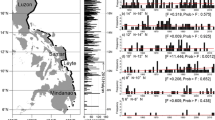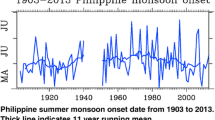Abstract
Saharan cyclones are an important feature of the seasonal spring climate of Saudi Arabia. It was found in an objectively tracking scheme that of 688 Sahara tracks, 53 of them reached Saudi Arabia during the period 1958–2018. Two distinct regions of cyclogenesis are identified: the first is Area A (Algeria, in particular, south of the Atlas Mountains) and the second is Area B (Libya and Egypt). The 53 tracks that pass or abate over Saudi Arabia are ultimately categorized into five key routes. The Saharan cyclones intensify near or over the Mediterranean, develo** a relatively strong pressure gradient during their lifetimes which weakens as they pass over the Arabian Peninsula. Cyclones develop usually under a tropical trough over North Africa, which is accompanied by a thermal ridge with a very strong temperature gradient. This pattern is also found at upper levels of the atmosphere. During the cyclones’ movement over Saudi Arabia, they extend upwards, and at higher levels, pressure levels of up to 500 hPa can be observed. The study also revealed that more tracks occur during the negative phase of the North Atlantic Oscillation, reflecting the role played by subtropical high pressure in controlling the movement of the Saharan cyclones. Cyclones originating over Area B are more frequent in recent decades than in the earlier decades. Cyclones originating in Area B are found to have more influence on the climate of Saudi Arabia than those occurring in Area A. Saharan cyclones that reach Saudi Arabia substantially increase the frequency of dust storms, raise the minimum temperature and maximum wind speed, and cause a reduction in minimum visibility. These results suggest how they may contribute to weather forecasts for the region.














Similar content being viewed by others
References
Ackerman SA, Cox SK (1989) Surface weather observations of atmospheric dust over the southwest summer monsoon region. Meteorol Atmos Phys 41:19–34
Al-Hurban AE, Al-Ostad AN (2010) Textural characteristics of dust fallout and potential effect on public health in Kuwait City and suburbs. Environ Earth Sci 60:169–181
Almazroui M, Tayeb O, Mashat AS, Yousef A, Al-Turki YA, Abid MA, Bafail AO, Ehsan MA, Zahed A, Rahman MA, Mohorji AM, Kang IS, Noaman A, Omar M, Al-roqi AM, Ammar K, Al-Ghamdi AS, Hussein MA, Katib I, O’Brien E, Aljohani NR, Islam MN, Alsaedi A, Yang YM, Alkhalaf AK, Ismail M, Mashat A, Kucharski F, Assiri M, Ibrahim S, Tippett M, Rashid IU, Kamil S, Alahmadi A, Atif RM, Bajunaid MA, Hantoush AS (2017) Saudi-KAU coupled global climate model: description and performance. Earth Syst Environ 1(1). https://doi.org/10.1007/s41748-017-0009-7
Alpert P, Ziv B (1989) The Sharav cyclone: observations and some theoretical considerations. J Geophys Res 94:18495–18514. https://doi.org/10.1029/JD094iD15p18495
Alpert P, Neeman BU, Shay-El Y (1990) Climatological Analysis of Mediterranean Cyclones Using ECMWF Data. Tellus A: Dynamic Meteorology and Oceanography 42:65–77. https://doi.org/10.3402/tellusa.v42i1.11860
Ammar K, El-Metwally M, Almazroui M, Wahab MMA (2014) A climatological analysis of Saharan cyclones. Clim Dyn 43:483–501. https://doi.org/10.1007/s00382-013-2025-0
Barnston AG, Livezey RE (1987) Classification, seasonality and persistence of low frequency atmospheric circulation patterns. Mon Wea Rev 115:1083–1126
Dee DP, Uppala SM, Simmons AJ, Berrisford P, Poli P, Kobayashi S, Andrae U, Balmaseda MA, Balsamo G, Bauer P, Bechtold P, Beljaars ACM, van de Berg L, Bidlot J, Bormann N, Delsol C, Dragani R, Fuentes M, Geer AJ, Haimberger L, Healy SB, Hersbach H, Holm EV, Isaksen L, Kallberg P, Koehler M, Matricardi M, McNally AP, Monge-Sanz BM, Morcrette JJ, Park BK, Peubey C, de Rosnay P, Tavolato C, Thepaut JN, Vitart F (2011) The ERA-Interim reanalysis: configuration and performance of the data assimilation system. QJR Meteorol Soc 137:553–597. https://doi.org/10.1002/qj.828
Ehsan MA, Almazroui M, Yousef A (2017) Impact of different cumulus parameterization schemes in Saudi-KAU AGCM. Earth Syst Environ 1(1). https://doi.org/10.1007/s41748-017-0003-0
Flocas HA, Simmonds I, Kouroutzoglou J, Keay K (2010) On cyclonic tracks over the eastern Mediterranean. J Clim 23:5243–5257
Ganor E, Foner HA, Brenner S, Neeman E, Lavi N (1991) The chemical composition of aerosols settling in Israel following dust storms. Atmos Environ 25:2665–2670. https://doi.org/10.1016/0960-1686(91)90196-E
Goudie AS, Middleton NJ (2002) Saharan dust storms: nature and consequences. Earth-Sci Rev 56:179–204
Hsu N, Gautam R, Sayer AM, Bettenhausen C, Li C, Jeong MJ, Tsay S-C, Holben BN (2012) Global and regional trends of aerosol optical depth over land and ocean using SeaWiFS measurements from 1997 to 2012. Atmos Chem Phys 12:8037–8053
Islam MN, Almazroui M, Dambul R, Jones PD, Alamoudi AO (2014) Long-term changes in seasonal temperature extremes over Saudi Arabia during 1981–2010. Int J Climatol 35:1579–1592. https://doi.org/10.1002/joc.4078
Israelevich PL, Ganor E, Levin Z, Joseph JH (2003) Annual variations of physical properties of desert dust over Israel. J Geophys Res 108(D13):4381. https://doi.org/10.1029/2002JD003163
Kalnay E, Kanamitsu M, Kistler R, Collins W, Deaven D, Gandin L, Iridell M, Saha S, White G, Woollen J, Zhu Y, Chelliah M, Ebisuzaki W, Higgins W, Janowiak J, Mo KC, Ropolewski C, Wang J, Leetma A, Reynolds R, Jenne R, Joseph D (1996) The NCEP/NCAR 40-year Reanalysis project. Bull Am Meteorol Soc 77:437–471
Kistler R, Collins W, Saha S, White G, Woollen J, Kalnay E, Chelliah M, Ebisuzaki W, Kanamitsu M, Kousky V, vanden Dool H, Jenne R, Fiorino M (2001) The NCEP/NCAR 50-year Reanalyses: Monthly CD-ROM and documentation. Bull Am Meteorol Soc 82:247–267
Kouroutzoglou J, Flocas HA, Keay K, Simmonds I, Hatzaki M (2012) On the vertical structure of Mediterranean explosive cyclones. Theor Appl Climatol 110:155–176
Kutiel H, Furman H (2003) Dust storms in the Middle East: sources of origin and their temporal characteristics. Indoor Built Environ 12:419–426
Lim EP, Simmonds I (2002) Explosive cyclone development in the Southern Hemisphere and a comparison with Northern Hemisphere events. Mon Wea Rev 130:2188–2209
Mahowald N, Luo C, del Corral J, Zender CS (2003) Interannual variability in atmospheric mineral aerosols from a 22-year model simulation and observational data. J Geophys Res 108(D12):4352. https://doi.org/10.1029/2002JD002821
Murray RJ, Simmonds IH (1991) A numerical scheme for tracking cyclone centres from digital data. Part I: Development and operation of the scheme. Australian meteorological magazine 39(3):155–166
Neu U, Akperov MG, Bellenbaum N, Benestad R, Blender R, Caballero R, Cocozza A, Dacre HF, Feng Y, Fraedrich K, Grieger J, Gulev S, Hanley J, Hewson T, Inatsu M, Keay K, Kew SF, Kindem I, Leckebusch GC, Liberato MLR, Lionello P, Mokhov II, Pinto JG, Raible CC, Reale M, Rudeva I, Schuster M, Simmonds I, Sinclair M, Sprenger M, Tilinina ND, Trigo IF, Ulbrich S, Ulbrich U, Wang XL, Wernli H (2013) IMILAST: a community effort to intercompare extratropical cyclone detection and tracking algorithms. Bull Am Meteorol Soc 94:529–547. https://doi.org/10.1175/BAMS-D-11-00154
Nissen KM, Leckebusch GC, Pinto JG, Renggli D, Ulbrich S, Ulbrich U (2010) Cyclones causing wind storms in the Mediterranean: characteristics, trends and links to large-scale patterns. Nat Hazards Earth Syst Sci 10:1379–1391
Notaro M, Alkolibi F, Fadda E, Bakhrjy F (2013) Trajectory analysis of Saudi Arabia dust storm. J Geophys Res Atmos 118:6028–6043
Pezza AB, Ambrizzi T (2003) Variability of southern hemisphere cyclone and anticyclone behavior: further analysis. J Clim 16:1075–1083. https://doi.org/10.1175/1520-0442(2003)0161075:VOSHCA%5b2.0.CO;2%5d
Pezza AB, Simmonds I, Renwick JA (2007) Southern hemisphere cyclones and anticyclones: recent trends and links with decadal variability in the Pacific Ocean. Int J Climatol 27:1403–1419. https://doi.org/10.1002/joc.1477
Pinto JG, Spangeh T, Ulbrich U, Speth P (2005) Sensitivities of cyclone detection and tracking algorithm: individual tracks and climatology. Meteorol Z 14:823–838
Prospero JM, Ginoux P, Torres Q, Nicholson SE, Gill TE (2002) Environmental characterization of global sources of atmospheric soil dust Identi fied with the Nimbus 7 Total Ozone Map** Spectrometer (TOMS) absorbing aerosol product. Rev Geophys 40(1):1002. https://doi.org/10.1029/2000RG000095
Radinović D (1987). Mediterranean cyclones and their influence on the weather and climate. PSMP report series 24. WMO, Geneva, p 131
Raible CC, Della-Marta P, Schwierz C, Wernli H, Blender R (2008) Northern Hemisphere extratropical cyclones: a comparison of detection and tracking methods and different reanalyzes. Mon Weather Rev 136:880–897
Shao Y (2001) A model for mineral dust emission. J Geophys Res 106(D17):20239–20254
Thalib L, Al-Taiar A (2012) Dust storms and the risk of asthma admissions to hospitals in Kuwait. Sci Total Environ 433:347–351
Thorncroft CD, Flocas HA (1997) A case study of Saharan cyclogenesis. Mon Weather Rev 125:1147–1165
Trigo IF, Davies TD, Bigg GR (1999) Objective climatology of cyclones in the Mediterranean region. J Clim 12:1685–1696
Washington R, Todd M, Middleton NJ, Goudie AS (2003) Dust-storm source areas determined by the total ozone monitoring spectrometer and surface observations. Ann Geophys 93(2):297–313
Yu Y, Notaro M, Liu Z, Kalashnikova O, Alkolibi F, Fadda E, Bakhrjy F (2013) Assessing temporal and spatial variations in atmospheric dust over Saudi Arabia through satellite, radiometric, and station data. J Geophys Res Atmos 118:13253–13264. https://doi.org/10.1002/2013JD020677
Author information
Authors and Affiliations
Corresponding author
Electronic supplementary material
Below is the link to the electronic supplementary material.
Rights and permissions
About this article
Cite this article
Almazroui, M., Ammar, K., Islam, M.N. et al. Spring Saharan Cyclones over Saudi Arabia: Preliminary Study of the Impacts on Climate. Earth Syst Environ 3, 153–171 (2019). https://doi.org/10.1007/s41748-019-00098-w
Received:
Accepted:
Published:
Issue Date:
DOI: https://doi.org/10.1007/s41748-019-00098-w




